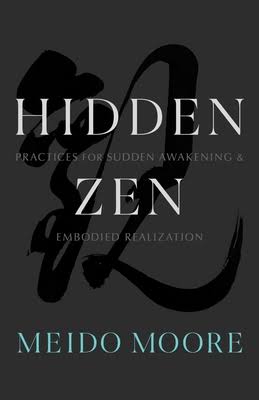Book Extract: Hidden Zen by Meido Moore
Practices for Sudden Awakening & Embodied Realization
In his latest book the abbot of Korinji monastery in Wisconsin introduces us to the less-well known (at least in the West), Rinzai practices of internal energy cultivation and mantra practices.

Book cover
Zen has always stated quite clearly that its path is open to both monastics and laypersons and that the most profound realization of awakening may indeed be attained in the midst of everyday life. But this is rather different from a modern conceit that seems increasingly common: that profound awakening may be grasped without exhaustive, devoted practice over many years - practice of such intensity that one’s “everyday life” will indeed appear rather different from the usual everyday life.
It has become common to hear statements from Buddhist practitioners revealing that, far from integrating daily life within their practice, they have instead undertaken to adjust practice to fit their daily lives. The idea has arisen that what is essentially an inconsistent effort to remain mindful, undistracted, and present throughout one’s day constitutes practice and is itself sufficient. Though certainly important, such efforts are a far cry from the effortless and seamless meditative state, unified with the upwelling of that recognition first arrived at in kensho,* that is actual liberation. It is not without reason that a master as great as Torei Enji, who practiced in a rigorous manner that few modern persons would endure said:
It is relatively easy to accomplish the important matter of insight into one’s true nature, but uncommonly difficult to function freely and clearly [according to this understanding], in motion and in rest, in good and in adverse circumstances. Please make strenuous and vigorous efforts to this end, otherwise all the teachings of Buddhas and patriarchs become mere empty words.
I thus fear that the Western Zen landscape may one day be finally reduced to a dry, stagnant expanse of shallow sitting practice and self-referential “mindfulness,” while orally transmitted methods like those we will examine - hidden treasures of our lineages - could be entirely lost. It is naturally incumbent upon Zen teachers in each generation to maintain the core principles of practice, while also seeking innovative ways to present the teachings in a manner matching the needs of contemporary people (whether that is by according with current conditions or decisively challenging them). Yet principles are transmitted using methods and forms, and the process of adaptation and transformation is most successfully accomplished when allowed to happen organically. This is something like transplanting a tree from one place to another: the old soil must be taken with the roots, and over time this can meld with the new ground. Therefore, in the short term at least, I will be grateful if by means of this book some old soil is preserved that might otherwise be washed away.
If a few of the many inherited Zen practices can be kept alive within even a handful of lineages, we can indeed hope that a truly healthy, native Zen will take root in the West. And finally, I should say that if dire predictions of worldwide environmental and social collapse come to pass, I would certainly hope that books like this might help some Zen practices to survive, even if it comes down to the smallest thread.
* kensho (Jpn.). "Seeing one's nature," a decisive awakening not different in substance - though often in depth - from that attained by the Buddha under the bodhi tree. Kensho is considered the entrance into authentic Zen practice, as well as the basis of subsequent practice to completely embody awakening.
(Hidden Zen:d Practices for Sudden Awakening & Embodied Realization by Meido Moore, pub. Shambhala 2020)




